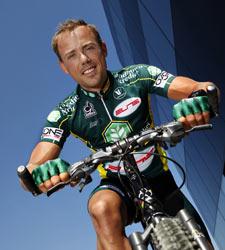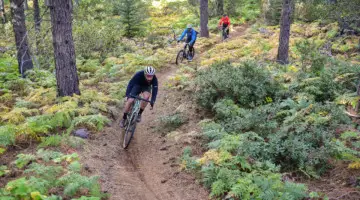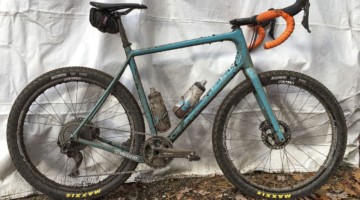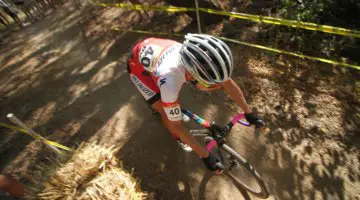Cyclocross is an exceptional sport in one major aspect: you can get into the sport racing on whatever bike you have around, and have a blast doing it. If you’re planning on using a mountain bike for your first race, there are a few minor changes you can make to have a better race. In this article, originally run in 2009, David Alden-St.Pierre shares some great advice on how to get your mountain bike ready for cyclocross season, if you’re not ready to commit to a ’cross-specific bike just yet. (Of course, when you are ready to look for a cyclocross bike, be sure to check out our Bike Reviews section!)
by David Alden-St.Pierre
I know you because I was you: a mountain biker at heart, but interested in all forms of cycling. I had read about cyclocross in the mags and online, but after checking out one race—and seeing exhausted, muddy riders battling the elements, each other, and the barriers—I knew had to try it for myself. I’ve been hooked ever since.
Fortunately it was pretty easy to make one of my mountain bikes ‘cross worthy, and that was enough to get me by for a few seasons. I think any cross-country oriented mountain bike will work for cyclocross racing, with a few caveats. A hardtail is best, but a full-suspension bike isn’t a deal breaker. It’s like bringing combat boots to a 5K run. The equipment will work, but will probably put you out of contention for a podium spot. That being said, I’ve seen some sub-20lb, super-efficient, “no-bob” full suspension bikes with traditional front triangle designs, which would be fine to take to the starting line.
It took me a couple of seasons before I added a true cyclocross bike to my stable and, to be honest, it’s only because I’m a bike junkie that I did so. My modified hardtail mountain bike was really all I needed to be mid-pack fodder. If you’ve been itching to give ’cross a try, and you don’t have the coin to buy a ’cross specific bike, here’s how to take your mountain bike out of the woods and into the world of cowbells and Belgian legends.
First, remove any additional accessories, including racks, reflectors, mirrors, bells, water bottles and cages, packs, lights or bar-ends. You’re not going to need any of that stuff and most of it isn’t allowed anyway. That’s really all you “need” to do, because of the rules against bar-ends and whatnot. But if you’re planning on hitting a couple of ’cross races, or you just want to dedicate your MTB to a season of ’cross races, here are a few more steps you can follow.
Frame/Fork: Like I mentioned above, a hardtail is best for a number of reasons. First, all things being equal, a hardtail will typically be lighter than a full suspension frame—this is important not only for acceleration, but also in the sections when you have to carry your bike. And speaking of carrying your bike, a regular front triangle design will allow for easier shouldering of the bike in run-up sections. Do you have to shoulder your bike? No, but there are times it’s easier, and some mountain bike frame designs will simply not work (think Trek Y-bikes). Another reason hardtail bikes are going to be better than full suspension bikes is that you simply don’t need the suspension, so you’d be carrying extra weight for nothing. Hardtails are more efficient as well, no matter how good your suspension design is. If all you’ve got is full suspension, well, lock it out if you can and still show up for the cyclocross party. I used to drag one of my buddies out to the races with me and he rode a ProFlex dualie. He still had fun.
When it comes to the fork, I’d say rigid is better there too, and for all of the same reasons as above (weight, efficiency). Swapping out forks isn’t all that time consuming, so it’s certainly feasible to keep both a rigid fork (of which, many are available for short money) and a suspension fork on hand, and you could swap them depending on your riding agenda. Have the same headset race mounted to each fork and the switcheroo should only take about ten minutes.
Tires/Wheels: You’ll note that the terrain for ’cross races is not nearly as technical as your typical singletrack trail. With that in mind, super knobby 2.2 tires are only going to slow you down. Switch to a narrow pair of semi-slick tires such as the Kenda Short Tracker (1.90) or the Kozmik Lite II (1.75). Low profile tires with good side knobs for cornering work best.
Tires are easy to swap as conditions/needs change, but you could go so far as having an extra set of wheels with your “cyclocross ready” tires already mounted. If you were sticking with the typical 26″ wheel size, any lightweight cross-country wheelset would be fine.
If you’re running disc brakes, you COULD put 700c (29’er) wheels on a 26″ mountain bike frame. As long as you use true 700c cyclocross tires, there should be enough clearance on MOST frames/forks. If you’re running linear pull brakes you still have options. Mavic makes a nifty adapter (Mavic 700c Brake Adapter) that attaches to brake post mounts and changes the brake’s position to allow for larger wheels. I have a pair of these on my commuter bike (regular 26″ hardtail mountain bike now with 700c wheels and cyclocross tires), and they work great. If you’re a weight weenie, you might balk at the additional grams but you can always drill holes in your frame to offset that (kidding, of course).
Before you switch wheels, be sure to double check the spacing between the rear dropouts. Road wheels might have rear hubs that are 130mm wide while mountain bike hubs are usually 135mm wide. Check out the late, great Sheldon Brown’s Web site for more information about frame/hub compatibility, or check with your local shop.
Drivetrain/Brakes: First, choose a clipless pedal that functions well in the mud, such as those offered by TIME and Crank Brothers. Make sure you’re adept at getting in and out of your pedals quickly, as you’ll be doing that quite a bit in a ‘cross race. To some newbie riders, platform pedals and running shoes may seem like a good idea (considering the running sections), but think of it this way: if that system worked well, everyone would be doing it. The positive connection between clipless pedals and the shoe cleats still reigns supreme.
When it comes to making changes to cranks, derailleurs and shifters, I’d say that in most cases you could leave these alone. You could switch to a rear cassette with taller gears as you’re probably not going to need a 12-34 in the back. You could also remove your granny gear, to save a little weight, and limit the front derailleur. I’m lazy so I didn’t do any of that to my converted mountain bike. Truth be told, I’m close to having all but my road bike be singlespeed, so gears and derailleurs bore me.
My original converted mountain bike had linear-pull brakes and they worked fine. I hear the arguments for cantilever brakes, but my personal opinion is that when V-brakes hit the scene they worked better and were an improvement over canti’s. Also, I’ve ridden plenty of muddy mtb courses and even with my fat tires I still had enough mud clearance. Enough said there because I think disc brakes are even better.
For the rest of us, this is where you’re going to have to make some serious decisions as to really how far you want to go to convert your bike. If you want to swap out your flat bar for drop bars, you’re going to have to change your shifters/brake levers. The shifters should work fine (road shifters with MTB derailleurs or vice-versa), but road brake levers will not work well with linear pull brakes, nor will they work optimally with disc brakes. Personally, I say stop here and use whatever handlebar/brake/shifter setup you’ve got. If you go much further with the conversion, why not just take the next step and buy a ’cross bike?
Well, that covers: frame, fork, wheels, tires, cranks, brakes, shifters, levers and pedals. That leaves rider cockpit items such as your stem as well as your seat and seatpost. If your fit is good and you’re comfortable on your bike, don’t change a thing. A more stretched out position may be better in the long run but, unless your mountain bike is set up so that your back is straight up when you’re riding, you should be fine. After a couple of races, you’ll know if you need to make any fit changes.
There you have it, now you’ve got no excuses. So toss your bike in the stand, grab a Duvel and ring that cowbell like you just don’t care.































